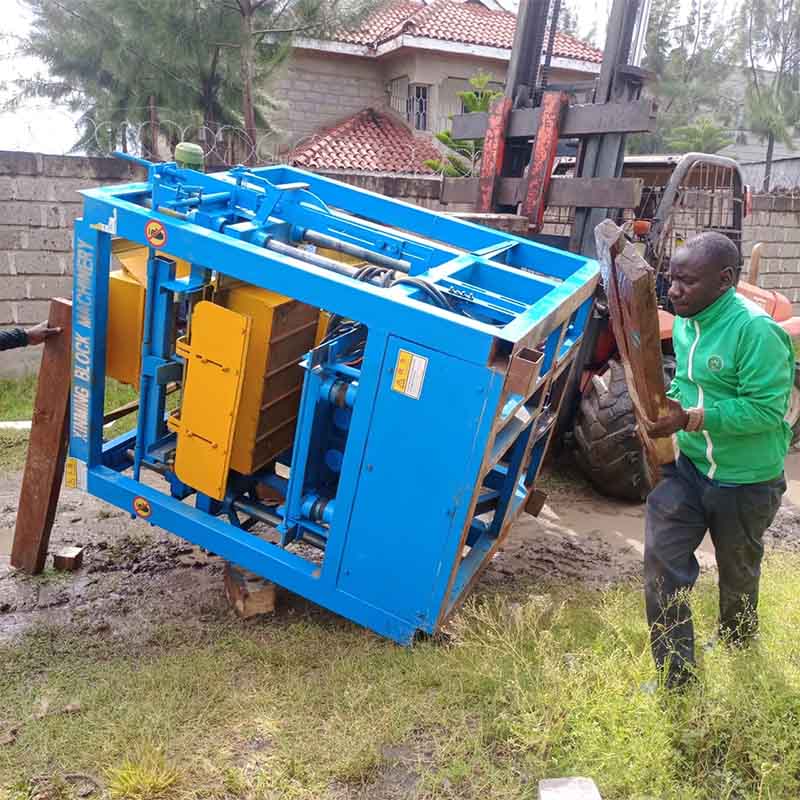
Image source Aiweibrickmachine
Semi-Automatic Block Machines in Disaster Relief and Reconstruction
The devastating impact of natural disasters, from earthquakes and hurricanes to floods and wildfires, leaves communities in disarray, often necessitating urgent relief and long-term reconstruction efforts. In these critical situations, semi-automatic block machines have emerged as invaluable tools for disaster relief and post-disaster reconstruction projects. Their capacity to efficiently produce high-quality concrete blocks, adapt to varying conditions, and offer sustainability benefits make them essential assets in helping affected communities recover and rebuild. In this extensive exploration, we delve into the multifaceted role of semi-automatic block machines in disaster relief and reconstruction, examining case studies, best practices, and the broader implications for resilient communities.
Section 1: The Urgent Need for Disaster Relief and Reconstruction
1.1 The Impact of Natural Disasters
Natural disasters can wreak havoc on infrastructure, homes, and entire communities, leading to loss of life, displacement, and long-term economic and social challenges.
1.2 The Role of Semi-Automatic Block Machines
Semi-automatic block machines offer a rapid and efficient solution for producing concrete blocks, which are vital for rebuilding structures and infrastructure in the aftermath of disasters.
Section 2: Case Studies in Disaster Relief and Reconstruction
2.1 Case Study 1: Earthquake Recovery in Nepal
Following the devastating earthquake in Nepal in 2015, semi-automatic block machines played a pivotal role in producing earthquake-resistant concrete blocks for rebuilding homes and schools.
2.2 Case Study 2: Hurricane Katrina Reconstruction in New Orleans
The aftermath of Hurricane Katrina required extensive reconstruction efforts. Semi-automatic block machines were used to produce durable blocks for rebuilding levees, homes, and other critical infrastructure.
2.3 Case Study 3: Typhoon Haiyan Recovery in the Philippines
The Philippines faced widespread destruction after Typhoon Haiyan. Semi-automatic block machines were deployed to produce concrete blocks for resilient housing and community structures.
2.4 Case Study 4: Flood Resilience in Bangladesh
Frequent flooding in Bangladesh necessitated the construction of flood-resistant buildings. Semi-automatic block machines contributed to producing blocks that could withstand water damage.
Section 3: Advantages of Semi-Automatic Block Machines in Disaster Relief
3.1 Rapid Block Production
Semi-automatic block machines can produce blocks at a high rate, expediting the construction process and enabling faster recovery.
3.2 Customization for Resilience
These machines offer flexibility in block design, allowing for the production of earthquake-resistant, flood-resistant, and hurricane-resistant blocks tailored to specific disaster-prone regions.
3.3 Sustainable Reconstruction
Semi-automatic block machines can incorporate sustainable practices, such as using eco-friendly materials and energy-efficient processes, aligning with disaster-resilient and eco-conscious reconstruction goals.
3.4 Local Job Creation
In disaster-affected regions, deploying semi-automatic block machines creates employment opportunities, empowering local communities to actively participate in their own recovery.
Section 4: Challenges and Solutions
4.1 Accessibility and Transportation
Access to semi-automatic block machines in remote or disaster-stricken areas can be challenging. Solutions include mobile units and partnerships with relief organizations.
4.2 Skilled Labor Shortages
Operating these machines effectively requires skilled personnel. Training and skill development programs can address this challenge.
4.3 Cost Constraints
Acquiring and maintaining semi-automatic block machines can be costly. Public-private partnerships and international aid can provide financial support.
Section 5: Community Engagement and Resilience
5.1 Engaging Communities
Incorporating local communities into the rebuilding process fosters a sense of ownership and resilience. Community-led initiatives often lead to more sustainable and culturally relevant solutions.
5.2 Disaster-Resilient Design
Semi-automatic block machines enable the production of blocks with advanced designs that enhance structural resilience. Community input is essential in designing structures that meet local needs and conditions.
5.3 Long-Term Resilience
Semi-automatic block machines support the construction of resilient infrastructure that can withstand future disasters, ensuring the long-term safety and well-being of communities.
Section 6: Sustainability and Disaster Relief
6.1 Eco-Friendly Materials
The use of sustainable and locally sourced materials in block production reduces the environmental impact of reconstruction efforts.
6.2 Energy Efficiency
Semi-automatic block machines equipped with energy-efficient features and processes contribute to a greener and more sustainable reconstruction process.
6.3 Waste Reduction
The precise manufacturing capabilities of these machines minimize waste, which is crucial in resource-constrained disaster relief contexts.
Section 7: Future Outlook and Resilient Communities
7.1 Technological Advancements
Continued innovation in semi-automatic block machine technology will enhance their efficiency, adaptability, and sustainability in disaster relief and reconstruction.
7.2 Community-Centered Approaches
Future disaster relief efforts will increasingly focus on empowering communities, ensuring their active participation in decision-making and reconstruction processes.
7.3 Climate Resilience
As the frequency and intensity of natural disasters increase due to climate change, the role of semi-automatic block machines in building climate-resilient structures becomes ever more critical.
Section 8: Conclusion
The deployment of semi-automatic block machines in disaster relief and reconstruction is emblematic of human resilience in the face of adversity. These machines represent not just the rebuilding of structures but the restoration of lives and communities. By expediting construction, enabling customization for resilience, and incorporating sustainability principles, semi-automatic block machines contribute to the creation of disaster-resilient communities capable of withstanding future challenges. As we look ahead, it is imperative that disaster relief efforts embrace technological advancements, community-centered approaches, and climate resilience strategies to ensure a safer and more secure future for all.
